Rank Species | Genus Acalypha Higher classification Acalypha | |
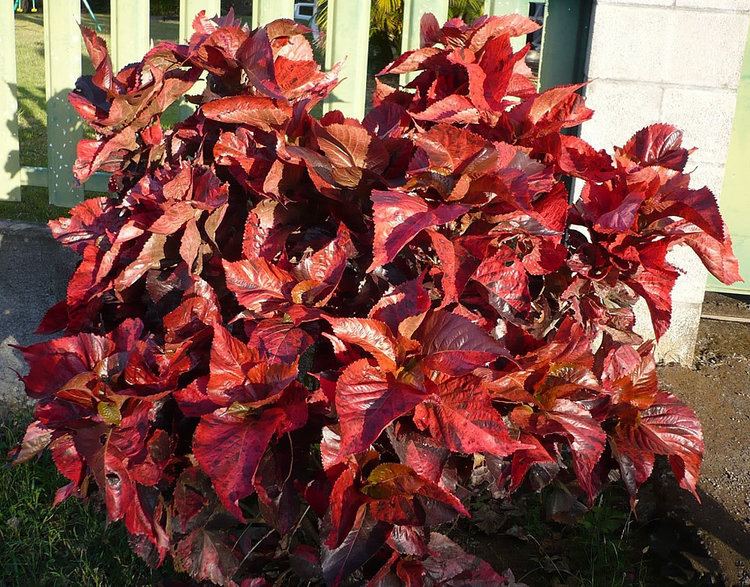 | ||
Similar Acalypha, Acalypha hispida, Euphorbiaceae, Acalypha australis, Acalypha chamaedrifolia | ||
Acalypha wilkesiana is an evergreen shrub. It grows 3 m high and spreads 2 m across. The stem is erect with many branches. The branches have fine hairs. It has a closely arranged crown. The leaves are coppery green with red splashes of colour. This gives them a mottled appearance. The leaves are large and broad with teeth around the edge. They can be 10–20 cm long and 15 cm wide. The leaves are finely hairy. They can be flat or crinkled. The flowers are reddish in spikes at the end of branches. They have separate male and female flowers on the same plant. The male flowers are in long spikes which hang downwards while the female flowers are in short spikes. They do not show up easily as they are often hidden among the leaves. The flower stalks are 10–20 cm long.
Contents
- Joseph s coat acalypha wilkesiana
- Distribution
- Diseases
- Light
- Moisture
- Hardiness
- Propagation
- Usage
- Medicinal value
- Features
- Found in
- Synonyms
- Other name
- References
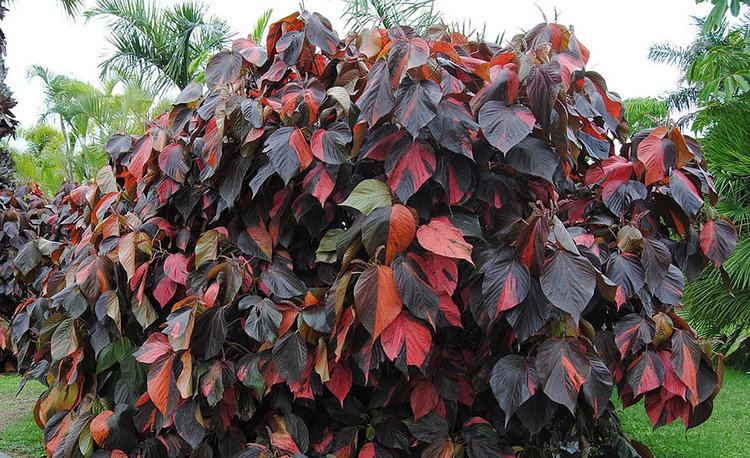
Joseph s coat acalypha wilkesiana
Distribution
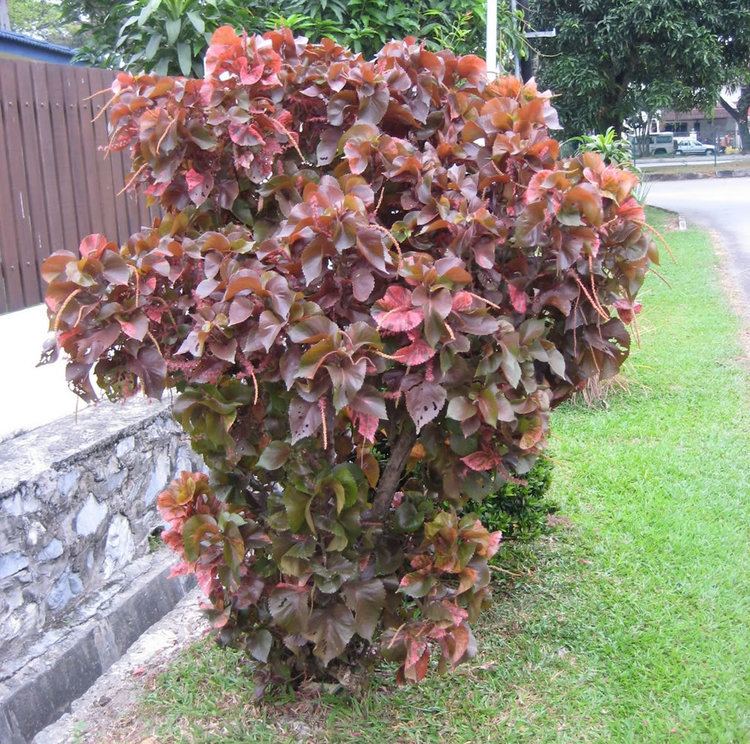
A. wilkesiana is a tropical and subtropical plant which grows naturally in Vanuatu and occurs in the Pacific Islands. It prefers light well drained soil and is suited to a protected shady position. It can be damaged by both drought and frost. It needs a minimum temperature above 10 °C. It is best suited to hardiness zones 9-12.
Diseases

The plant is susceptible to mealy bug infection, which can result in growth retardation and also cause high fungal contaminations in in vitro studies. To reduce the mealy bug’s infection, 90% ethanol can be directly applied to the infestations using paint brushes.
Light
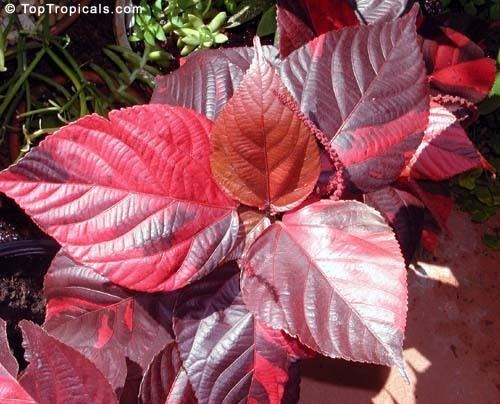
The plant, often called "copperleaf," does fine in partial shade or sun. It prefers a position sheltered from strong winds, and a fertile, organic soil. Indoor plants do well in medium light, but leaf colour develops best on plants kept in bright light.
Moisture
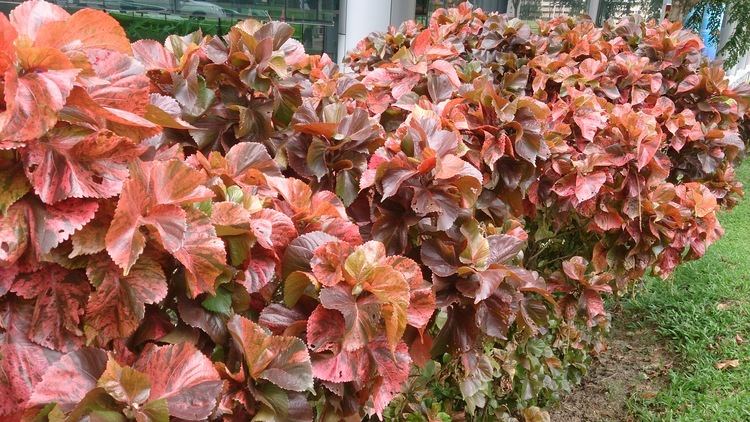
Outdoors, copperleaf does best in a rich, moist, but fast-draining soil. Indoor plants do better in a soilless potting mix, with the medium constantly moist, but not saturated. Daily misting is recommended for indoor plants with only spare watering in winter.
Hardiness
Copperleaf is suited to USDA Zones 10-11. Although growing best in USDA Zones 10-11, copperleaf seems to have established in Zone 9a in Central Florida. Indoor plants should be kept above 55 °F (13 °C). Copperleaf can also be grown as an annual.
Propagation
Propagation can be done by stem cuttings at any time of year, using bottom heat.
Usage
In South Florida and tropical America, copperleaf is a popular outdoor plant that provides colour throughout the year. It is used in mixed hedges and shrub borders and as a specimen shrub. Elsewhere copperleaf is grown as an annual where its spectacular foliage replaces flowers from late summer until frost. Copperleaf is also grown indoors as a container plant. However, it must be maintained in a warm, humid, bright environment.
The variegated cultivar 'Hoffmannii' has gained the Royal Horticultural Society's Award of Garden Merit.
Medicinal value
Acalypha wilkesiana ointment is used to treat fungal skin diseases. Oyelami et al. (2003) carried out a non-comparative study to evaluate the safety and efficiency of Acalypha wilkesiana ointment using 32 Nigerians with mycological as well as clinical evidence of mycoses. The ointment successfully controlled the mycoses in 73.3% of the affected patients.
It was very effective in treating Pityriasis versicolor, Tinea pedia and Candida intetrigo, with 100% cure. Oyelami et al. (2003) concluded that Acalypha wilkesiana ointment can be used to treat superficial mycoses. Akinyemi et al. (2005) evaluated crude extracts from six important medicinal plants, namely Phylantus discoideus, Ageratum conyzoides, Terminalia avicennioides, Bridella ferruginea, Acalypha wilkesiana and Ocimum gratissimum, to find activity against methicillin resistant Staphylococcus aureus (MRSA. Water and ethanolic extracts of these plants were obtained locally. MRSA strains isolated from patients were used. Both ethanolic and water extracts showed effects on MRSA. Minimum bactericidal concentration (MBC) and minimum inhibition concentration (MIC) of these plants ranged from 30.4-37.0 µg/ml and 18.2-24.0 µg/ml respectively. A high MBS value was found in two plants and the other four contained traceable amounts of anthraquinones. This study provided scientific support for the use of Acalypha wilkesiana, T. avicennioides, O. gratissimum and P. discoidens against MRSA based diseases. A. conyzoides and B. ferruginea were unresponsive against the MRSA strains.
Features
This remarkable plant has foliage that is more colourful than many flowers. Other names for Acalypha wilkesiana include A. amentacea and A. tricolor. There is another popular member of the genus Acalypha that is grown in South Florida and in greenhouses and conservatories as well. It is the red-hot-cattail (A. hispida) that is grown for its long brightly coloured, fuzzy catkins.
Found in
Africa, Asia, Australia, The Bahamas,Bermuda, Brazil, Fiji, Hawaii, Indochina, Indonesia, Kenya, Malaysia, Nigeria, Norfolk Island, Pacific, Pakistan, Papua New Guinea, PNG, Polynesia, Tanzania, Thailand, Tonga, Uganda, USA, Vanuatu, Vietnam.
Synonyms
Acalypha tricolor; Acalypha amentacea Roxb. var. wilkesiana (Muell. Arg.) Fosberg.
Other name
Flamengueira, Fijian fire plant, Fire Dragon Plant, Beefsteak Plant, Hu-ling, Redleaf, Joseph's coat, Hoja de Cobre, Huu-krataai, Tai tuong, Mexican payasito, Match-Me-If-You-Can
